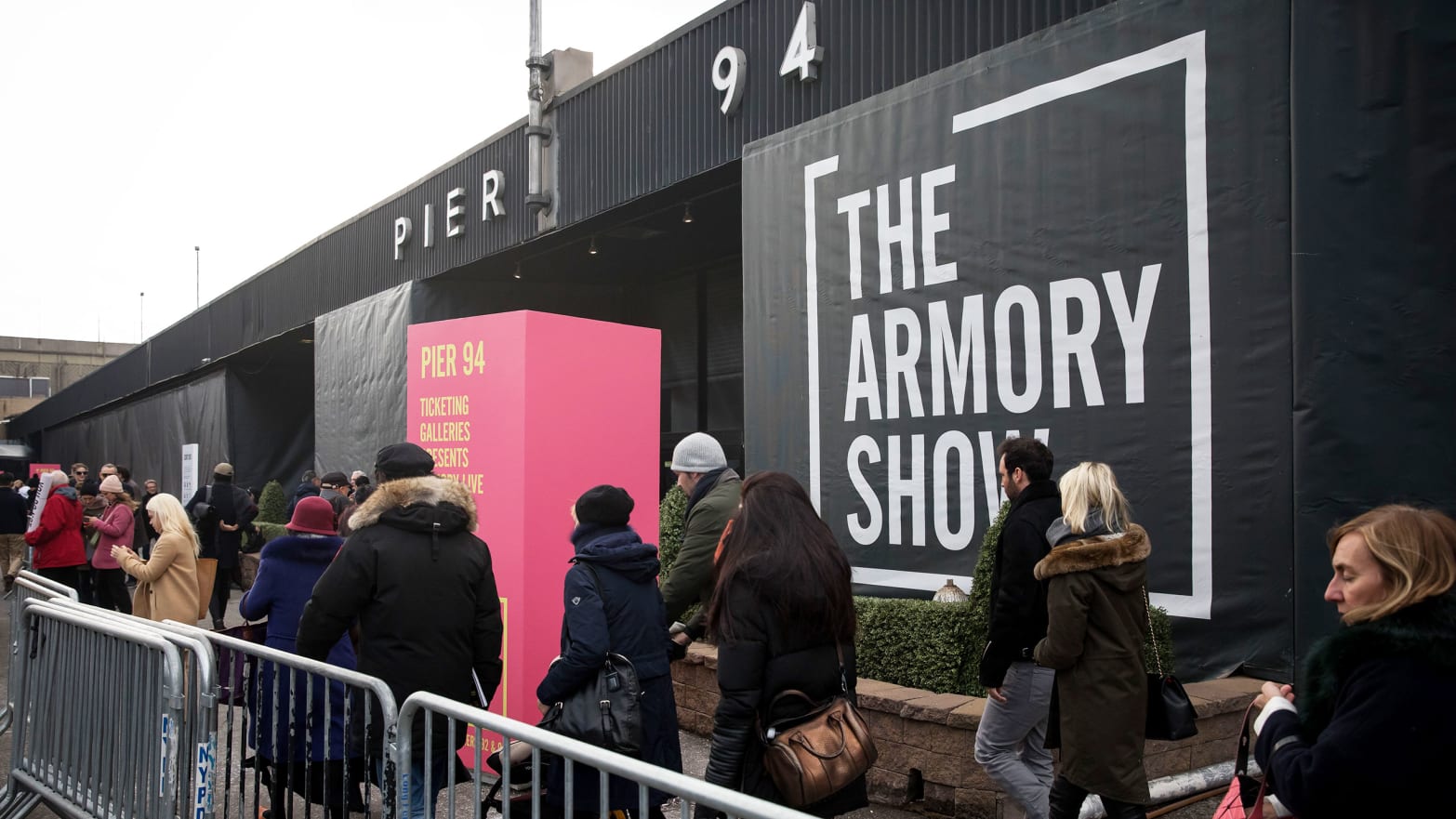Armory Week is that annual moment when the international art world descends on New York City and disgorges its insides on the vast grounds of a former passenger cruise ship terminal, ripping its soul open so that the global one percent can have a gander at what’s doing in the galleries these days.
It is a useful, soul-baring exercise. No one at the Armory Show talks about ideas or aesthetics or craft. The mask falls away so that you see what was really animating all of those white-walled galleries--the need to sell, sell, sell, fueling a speculative bubble that appears to be incapable of bursting.
On plush carpeting, as a vendor wheels a cart featuring medium-sized bottles of Pommery POP champagne for sale, here are some of the things I heard art dealers and art advisers tell would-be buyers, most of whom seem to have known each other from previous gatherings of the tribe the week before in Palm Springs or Madrid or Marrakech.
“You have to understand the provenance. If you can’t understand the provenance you really can’t understand the art.”
“The last time I went to the Bahamas we bought just like a tree of weed.”
“This isn’t the kind of art that you see yourself in. This is the kind of art that you are just in, seeing yourself.”
“We were last all together at the rooftop bar at the Delano in Miami!”
Stretching over two piers, the Armory Show can be a little disorienting, like wandering through a high-end airport mall only without the possibility of escape. To slow down and contemplate a piece of art would quickly label you a rube. In one corner, a woman played fetch with a tiny Tibetan spaniel wearing a bow-tie. It was mistaken for another exhibit, and maybe it was.
At one of the booths patrons could buy cheap, plasticky participation trophies, the kind you get for completing a season of Little League or some such, emblazoned with whatever message they wanted.
“Hot Stuff Award,” one woman requested, handing the gallerist a trophy in the shape of a ball of flame.
This isn’t to say that there isn’t a lot worth seeing if you are willing to fork over the $57 admission price. Leo Villareal’s Star Ceiling is a 75-foot long overhead installation that is the closest most of us will get to coursing through the upper cosmos.
In a space in which every square foot demands your attention, and so only the most eye-popping pieces give cause to stop over at, a quiet survey by the civil rights activist and multi-media artist Faith Ringgold featuring her US America Black series of quilts dedicated to lions of African American history is a rare respite and delight.
The opposite effect is achieved by the Cameroonian artist Pascale Marthine Tayou, whose Plastic Bags manages to muscle out of a lot of the noise and still overwhelm the viewer.
A 21-foot tall installation hanging from the ceiling of 25,000 multi-colored plastic bags that Tayou gathered for the piece, it manages to make a statement on the endless amounts of crap our globe must produce and the plastic bags we cart it all home in.
This isn’t the kind of art gesture that we call tongue-in-cheek; it slams home with the subtlety of a sledgehammer. What did however seem like the perfect winking piece, the coup de grâce of the whole affair, was the Brooklyn gallery which placed on one pedestal in the middle of its booth a simple silver credit card reader.
Here was a nod to Duchamp’s readymades, a quiet indictment of the global aristocratic oligarchy that washes its money through the world of contemporary art so that it can feel better about and achieve some frisson of edginess. When I inquired about the piece though, the gallerist told me that no, it was just a credit card reader, put there for convenience.
This is the Armory Show’s 25th year, and as the art fair circuit has grown around the world, its appearance in New York has led to a number of art fairs that open the same week, among them Scope, Independent, Clio and a few more.
Together they give a fairly complete view of the prevailing aesthetic in contemporary art, which by my lights is a kind of slap-dash, almost child-like attempt to render something that looks intentionally juvenile, overlain with a highly theoretical artist statement that reads like a work of art itself.
An installation of a dozen or so balloons floating against a pink background and powered by a handful of small fans is, in the description of the artist Graham Wilson a “theatrical site” in which “the viewer experiences vulnerability in fear of explosions. Through compelling and straightforward visual metaphors, the artist intends to create a contrast between happiness and destruction, health and death. The work also alludes to the murky practices of the pharmaceutical industry.”
Indeed.
That last work is on view at Spring/Break, now its eighth year and a useful counterpoint to the rest of Armory Week. There is a light-heartedness to Spring/Break, which this year takes over an otherwise nondescript suite of offices across the street from Trump World Tower.
This can lead to some predictable juxtapositions, like the black and white painting of the president sucking Steve Mnuchin’s fingers above a grieving war widow, but the whole thing doesn’t take itself too seriously, and there is a joy and lightness that can seem absent elsewhere in Armory Week.
One artist took a plaster cast of his foot and placed it on a swinging rod that gallery goers had to scramble to get away from while he, with arched eyebrow, explained the work’s deep artistic theory and provenance.
Or, a few feet away, there is another piece featuring a pink mannequin with an oversized member, rhythmically swinging around and knocking a seated, viewing mannequin in the face.
If there is a better metaphor of Armory Week, I haven’t found it.

